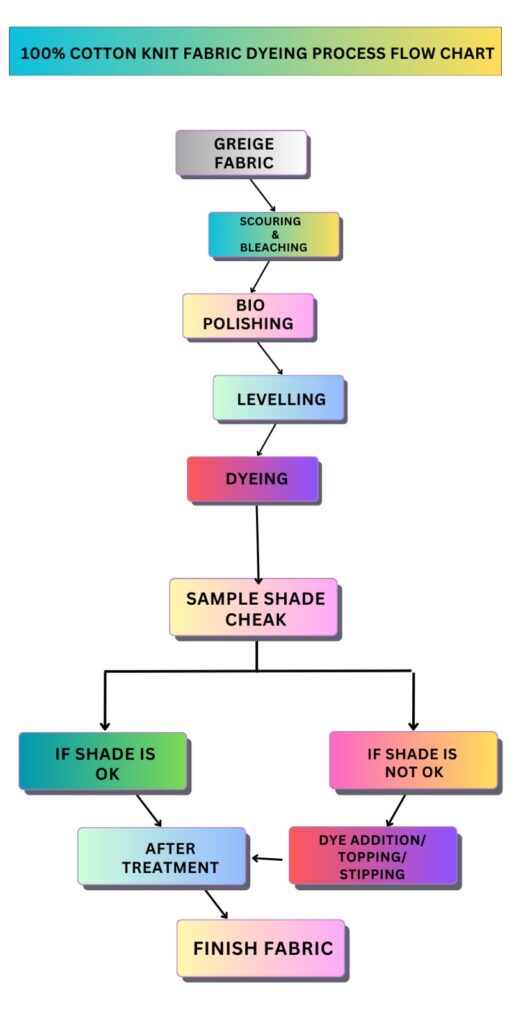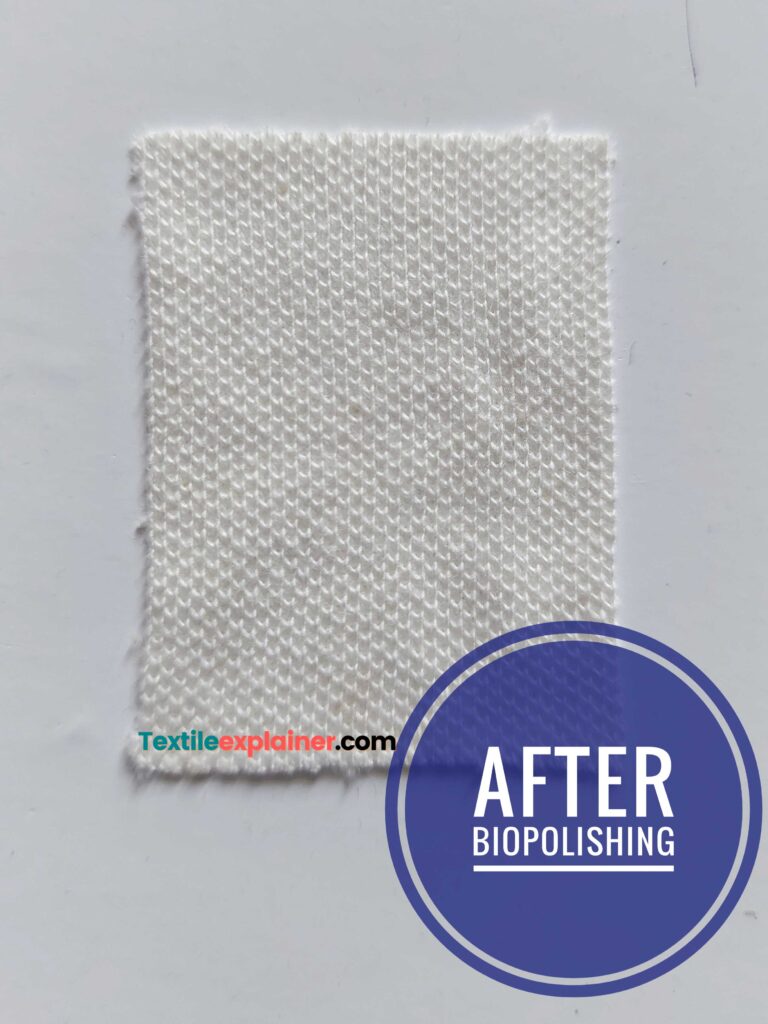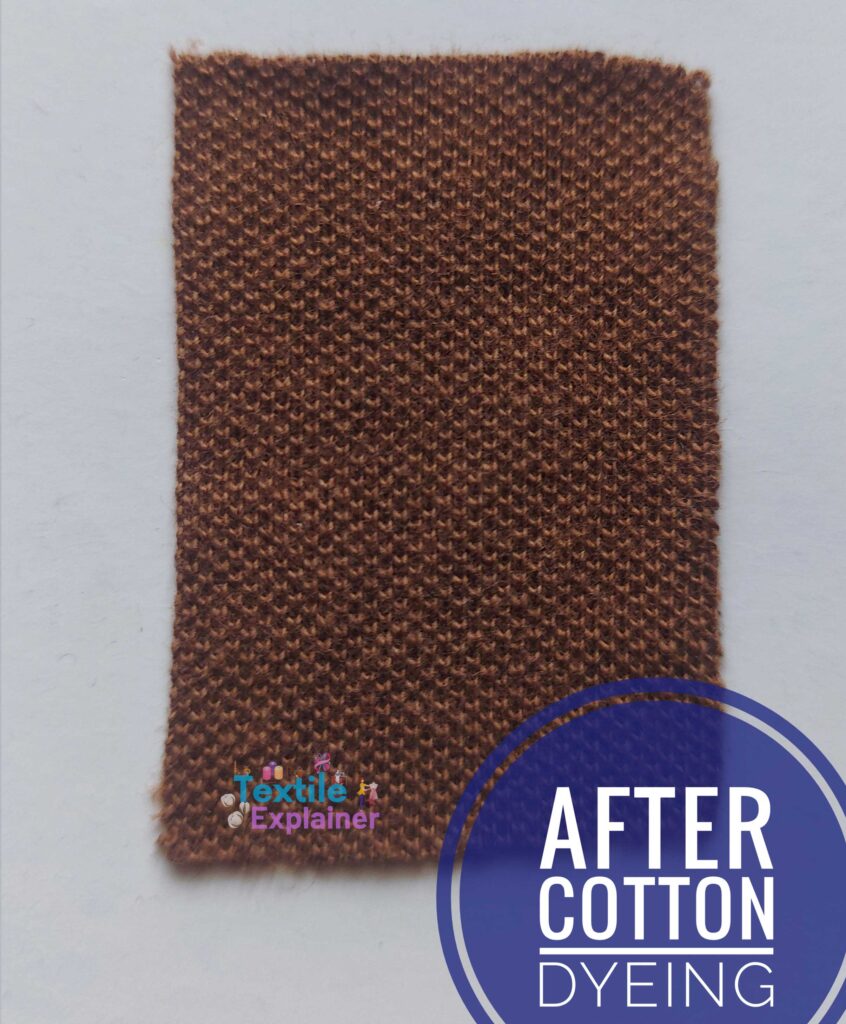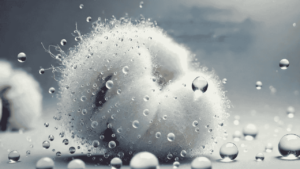The dyeing process for cotton knit fabric through the exhaust dyeing method is a meticulous journey. In this comprehensive guide, we drive deep into the intricate steps involved in transforming raw cotton into vibrant, dyed knit fabric. Explore the nuances of the exhaust dyeing method, from pretreatments and color application to fixation and finishing. Discover how this technique enriches cotton knits with vivid, long-lasting hues, unraveling the science and artistry behind this dyeing process
What is 100% cotton knit fabric:
100% cotton knit fabric is a type of textile material made completely from cotton fibers and produced by using a knitting process. Knitting involves interlocking loops of yarn to create a stretchy and breathable fabric. This results in a soft, comfortable, and versatile material that is commonly used for making T-shirts, underwear, sweaters, and various other clothing items. 100% cotton knit fabric types are s/j, rib, terry, fleece, pique, lacoste etc.
100% Cotton Knit Fabric Dyeing Process Flow Chart:

100% Cotton Knit Fabric Dyeing Description:
1) Demineralization:
We know that cotton grows naturally and that cotton absorbs minerals from the soil. Demineralization in cotton dyeing refers to the removal of mineral ions from the cotton fabric before the dyeing process. It is an essential step in the textile industry, as the presence of minerals in the fabric can interfere with the dyeing process and affect the quality of the dyed product.In this process wetting agents & sequestering agents are commonly used.
Why Demineralization is Necessary:
1.Mineral Interference: Minerals in water, such as calcium and magnesium ions, can form insoluble compounds with certain dyes, preventing them from effectively binding to the fabric.
2.Color Consistency: Removing minerals ensures uniform and consistent color uptake during the dyeing process, resulting in better color quality.

2)Scouring & Bleaching:
Scouring is the initial step in preparing cotton fabric, and it involves the removal of natural impurities, waxes, oils, and other substances present in the cotton fibers with the help of NaOH. This process ensures that the fabric is clean and ready to accept dyes or finishes evenly. And then bleaching is done with H2O2 to remove the natural color from the cotton greige fabric.
This process is described in brief..
In this textile processing procedure, the process begins by filling the machine with water at a temperature of 40⁰C. Detergent, an anticreasing agent, and a sequestering agent are injected into the water, followed by loading the fabric. The water temperature is then raised to 60⁰C, and caustic soda is dosed into the mixture for 7 minutes. Afterward, the temperature is increased to 70⁰C, and hydrogen peroxide is injected. The water temperature is further raised to 98⁰C, and the machine runs for 60 minutes. Subsequently, the water is cooled to 78⁰C, and a sample of the fabric is checked for absorbency and brightness. If the sample meets the criteria, the water is drained.
Next, the machine is refilled with hot water at 80⁰C, and a 10-minute cycle is run to wash the fabric clear. After washing, the water is drained and refilled again. Acetic acid is added to neutralize any remaining chemicals, followed by the injection of a peroxide killer, and a 5-minute run cycle. The effectiveness of the peroxide treatment is checked using peroxide paper. Finally, the water is drained once more, and a final wash cycle is performed before refilling the machine.

4) Boipolishing:
Biopolishing is a chemical process where the protruding fibers & slabs in the knitted cotton fabric are weakened with the help of cellulase enzyme and removed with the help of water pressure.
This process is also known as Enzymatic singeing. The reason for saying Enzymatic singeing is that in Singeing, the hairiness on the surface of the oven fabric are removed with the help of flame. On the other hand in Biopolishing, the hairiness of the knitted cotton fabric is removed with the help of enzymes.
The changes that occur in the fabric by biopolishing are:
1) Reduces fabric pilling.
2) Gives the fabric a smooth and soft hand feel.
Biopolishing is usually done at 45°-55°C and at acidic pH. A hot wash is then given at 80°C to deactivate the enzyme.

5) Levelling:
“Levelling” in cotton dyeing refers to the process of ensuring that the dye is evenly distributed and absorbed by the cotton fabric, resulting in uniform and consistent coloration.
A levelling agent is used before the dyeing step begins in the fabric. The purpose of using the leveling agent is to spread the dye chemicals evenly on the fabric.
In this step before fabric dyeing Sequestering agent, Anti-creasing agent, Defoaming agent etc are also used. Here control the pH in 6.5. Temperature 40°C for 5mins.
6) Dyeing:
After completing the levelling step than the fabric is ready for dyeing. Generally reactive dyes are used for cotton dyeing. Direct dyes & vat dyes are also used.
This step is described in brief..
The initial salt dosing for 10 minutes, followed by a 10-minute run, the process continues with color dosing for 30 minutes and another 20-minute run. A sample check is conducted to assess dye shade percentages and ensure levelness. If all is satisfactory, the temperature is raised to 60⁰C.
Next, a 15-minute soda dosing is carried out, followed by a 15-minute runtime. The remaining 90% of soda dosing takes 20 minutes, followed by a 20-minute runtime. Another sample check is performed, and if everything meets the standards, the bath is drained (preferably rinsed).
A 5-minute wash and drain fill is executed at normal hot (70⁰C), followed by a 10-minute run and a clear wash. Acetic acid is used for neutralization, and a final wash and drain complete the process, ensuring water clarity.

7) After-treatment:
The last process of dyeing is After-treatment. This process is done in 3 steps:
1)Soaping: In this step, the fabric is soaped with the help of detergent/soaping agent as a result of which the unfixed dyes are removed from the fabric surface.
In this step the soaping agent is injected and then the temperature is raised at 90°C for 10mins and than drain and wash.
2)Fixing: In this step fixing agent are used to improve color fastness of the dyed fabric. Fixing agents are also known as mordant or fixative.
Dossing the fixing agents for (5-15)mins and than drain and wash.
3)Softening: After fixing, the fabric is made soft and smooth with the help of softener.

Conclusion:
100% Cotton knit fabric is known for its natural feel, breathability, and ability to provide good moisture absorption, making it a popular choice for casual and activewear.
This fabric is an excellent choice for anyone looking to create a high quality textiles. Its durability, softness, smoothness & absorbency makes it ideal for a wide range of products.
Advantages of 100% cotton knit fabric include comfort, breathability, and its natural, hypoallergenic properties.
Disadvantages include susceptibility to wrinkles, shrinkage, and pilling over time with wear and washing.





0 thoughts on “100% Cotton Knit Fabric Dyeing Process – Exhaust Dyeing Method”
Thanks to Textile Explainer for publishing my article..💝
Thanks for your valuable article.
Thanks a lot brother..
Excellent Topic and more technical terms.
Great Great Great.
Thanks for the compliment.
Excellent topic and more technical.
Great Great
Thanks for the compliment.